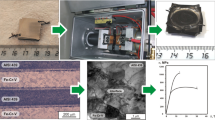Abstract
The influence of the technology of deposition of a surface layer on the structure of the diffusion zone and the adhesion strength of functional-gradient layered steel–aluminum composites has been investigated. The compositions made by arc cladding with complete melting of an explosion-welded intermediate aluminum layer are shown to be characterized by a continuous layer of ternary Fe–Al–Si intermetallic compounds with an average thickness of 10 μm and to have an adhesion strength of 43 MPa. The technology of arc cladding with partial melting of the intermediate explosion-welded aluminum layer is found to fabricate compositions with a discrete layer of Fe–Al intermetallic compounds with an average thickness of 17 μm and an adhesion strength of 66 MPa.









Similar content being viewed by others
REFERENCES
A. M. Drokonov, A. V. Osipov, and A. V. Biryukov, Turbine Plant Bearings: Tutorial (BGTU, Bryansk, 2009).
E. F. Parovai and I. D. Ibatullin, “Actual problems of reliability of friction units of gas turbine engines,” Vestn. Samar. Aerokosm. Univ. 14 (3), Part 2, 375–383 (2015).
R. S. Mikheev and T. A. Chernyshova, “Dispersed-reinforced composite materials of the Al–TiC system (review),” Zagot. Proizv. Mashinostr., No. 11, 44–53 (2008).
T. A. Chernyshova et al., “Development and testing of Al–SiC and Al–TiC composite materials for application in friction units of oil-production equipment, Inorg. Mater.: Appl. Res., No. 3, 322–329 (2011).
P. Garg et al., “Advance research progresses in aluminium matrix composites: manufacturing & applications,” J. Mater. Res. Technol. 8 (5), 4924–4939 (2019).
A. Hasanniah and M. Movahedi, “Gus tungsten arc lap welding of aluminium/steel hybrid structures,” Marine Struct. 64, 295–304 (2019).
R. S. Mikheev et al., “Influence of an intermediate aluminum layer on the mechanism of formation of intermetallic compounds in the synthesis of functionally-gradient layered steel–aluminum compositions,” Svarka Diagnost., No. 5, 19–23 (2018).
Q. Wang et al., “Effects of FeAl intermetallic compounds on interfacial bonding of clad materials,” Trans. Nonfer. Metals Soc. China 24, 279–284 (2014).
S. Saravanan, K. Raghukandan, and K. Hokamoto, “Improved microstructure and mechanical properties of dissimilar explosive cladding by means of interlayer technique,” Arch. Civ. Mech. Eng. 16, 653–658 (2016).
M. Mazar Atabaki et al., “Hybrid laser/arc welding of advanced high strength steel to aluminum alloy by using structural transition insert,” Mater. Design 75, 120–135 (2015).
A. A. Shtertser et al., “The use of explosive technologies for the production of sliding bearings for diesel engines,” Izv. Samar. Nauch. Tsentr RAN 4 (4), 1056–1060 (2011).
B. S. Zlobin et al., “Improvement of the technology of manufacturing steel–aluminum liners of sliding bearings,” Izv. VolgGTU, No. 14, 57–63 (2012).
B. S. Zlobin et al., “Features of the formation of a joint during explosion welding of an AO20-1 alloy with steel,” Izv. VolgGTU, No. 4, 51–63 (2012).
J. Kaur et al., “Cladding of stainless steel (SS304) on aluminium alloy (AA1100) by explosive welding,” Mater. Today: Proc. 5, 19136–19139 (2018).
R. S. Mikheev and T. A. Chernyshova, Aluminum-Matrix Composite Materials with Carbide Hardening for Solving New Engineering Problems (Maska, Moscow, 2013).
RD 31.28.09-93. Marine Sliding Bearings with an Antifriction Layer of an Alloy Based on Tin and Lead. Specifications for Materials. Typical Technological Processes (TsNIIMF, St Petersburg, 1993).
OST 92 8629–75. Connections of One-Piece Steel Parts with Aluminum through Bimetallic Adapters. Types. Specifications (1975), p. 37.
Y. Li et al., “Morphology and structure of various phases at the bonding interface of Al/steel formed by explosive welding,” J. Electron Microscopy 49 (1), 5–16 (2000).
RD 50-672–88. Methodical Instructions. Calculations and Strength Tests. Classification of Types of Fracture of Metals (Gos. Komitet SSSR po Standartam, Moscow, 1989).
V. I. Anikina and A. A. Kovalev, Fractography in Materials Science: Tutorial (Izd. Sib. Federal. Univ., Krasnoyarsk, 2014).
Funding
This work was performed according to state assignment no. 075-00947-20-00.
Author information
Authors and Affiliations
Corresponding author
Additional information
Translated by K. Shakhlevich
Rights and permissions
About this article
Cite this article
Mikheev, R.S., Kobernik, N.V. & Kalashnikov, I.E. Effect of the Process of Production of Functional Gradient Layered Steel–Aluminum Compositions on Their Structure and Properties. Russ. Metall. 2020, 1020–1026 (2020). https://doi.org/10.1134/S0036029520090104
Received:
Revised:
Accepted:
Published:
Issue Date:
DOI: https://doi.org/10.1134/S0036029520090104




